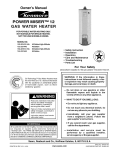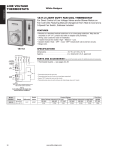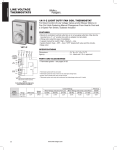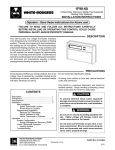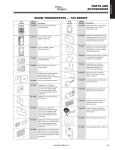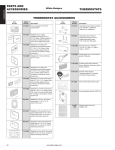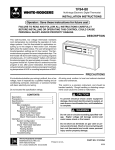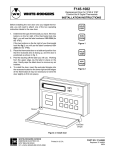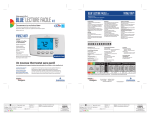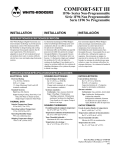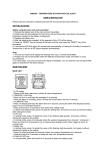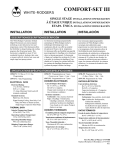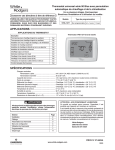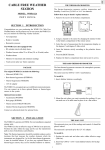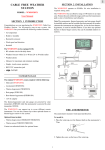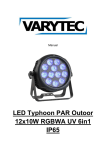Download White Rodgers F145-1328 Troubleshooting
Transcript
REMOTE SENSORS MAXIMUM SENSING LOCATIONS PER THERMOSTAT Indoor Sensing Locations Thermostat Model Number Single Stage Total (Max.) Thermostat Onboard Sensor Remote Sensor Remote Sensor Priority Assignment (LO/AVG/HI) Allows Outdoor Remote Sensor 1F90-371 1 OFF* With 1* - - 1F96-344 1 OFF* With 1* - - 1F97-1277, -0671 2 ON or OFF + 1 Yes Yes*** 1F97-371 1 OFF* With 1* - - 1F97-391 1 OFF* With 1* - - Sensor Set Up Clip Jumper W922 and Enable Sensor in Menu Clip Jumper W922 and Enable Sensor in Menu Enable Sensor in Menu Clip Jumper W922 and Enable Sensor in Menu Clip Jumper W922 and Enable Sensor in Menu Enable Sensor in Menu Enable Sensor in Menu Enable Sensor in Menu Enable Sensor in Menu Enable Sensor in Menu Enable Sensor in Menu Up to 3 Yes** Yes ON or OFF + 4 1F93-380 + ON or OFF 4 Up to 3 Yes** Yes 1F94-371 + 2 Yes*** 1 Yes 1F95-1277, -0671 ON or OFF Staging Up to 3 ON or OFF 4 Yes + Yes** 1F95-371 Yes 4 Up to 3 1F95-377 ON or OFF Yes** + Up to 3 Yes 1F95-391 Yes** ON or OFF 4 + *Using a Remote Sensor On This Model Requires the Onboard Thermostat Sensor To Be Off. **Allows A Sensor Priority of LO, AVG., or HI To Be Assigned To The Onboard Thermostat Sensor In Addition Remote Sensors. ***Accepts One Remote Sensor, Indoor or Outdoor. REMOTE SENSOR CALCULATED PRIORITY AVERAGE Consult Maximum Sensing Locations Per Thermostat chart above to determine how many sensors a thermostat will accept. Tables 1-3 show how priority (LO, AVG, HI) effects the room temperature calculation. The example below table three shows the calculation of each remote sensor and how it uses them to arrive at room temperature average. Table 1: Remote Sensor A configured as a LO priority sensor Remote Sensor SA Sensor Priority LO Priority Multiplier 1 Room Temperature 70°F (Sensor Temp.) Averaging Calculation 1 x 70 = 70 (Priority Multiplier x Room Temp.) Table 2: Remote Sensor B configured as a AVG priority sensor Remote Sensor SB Sensor Priority AVERAGE Priority Multiplier 2 Room Temperature 75°F (Sensor Temp.) Averaging Calculation 2 x 75 = 150 (Priority Multiplier x Room Temp.) Table 3: Remote Sensor C configured as a HI priority sensor Sensor Priority HI Priority Multiplier 4 Room Temperature 80°F (Sensor Temp.) Averaging Calculation 4 x 80 = 320 (Priority Multiplier x Room Temp.) The example below lists three sensors each with a different priority and room temperature. All three sensors are combined in the calculation to display the average temperature. The priority multiplier shown in the tables above causes a sensor with low priority to carry less weight in the calculated average. A sensor with a HI priority setting contributes more to the calculated average. Assume that the building in which the thermostat is located has three indoor remote sensors (SA, SB, SC) that have different room temperatures (70, 75, 80). The calculated average will be displayed as the room temperature shown in the example below. Example: Remote Sensors A, B, and C configured as a LO, AVG, and HI priority sensors Remote Sensor SA SB SC Sensor Priority LO AVERAGE HI Priority Multiplier 1 2 4 Room Temperature 70°F (Sensor Temp.) 75°F (Sensor Temp.) 80°F (Sensor Temp.) Averaging Calculation 1 x 70 = 70 (Priority Multiplier x Room Temp.) 2 x 75 = 150 (Priority Multiplier x Room Temp.) 4 x 80 = 320 (Priority Multiplier x Room Temp.) Avg. Calc. (540)/Sum Priority Mult. (7) 540/7 = 77°F (Calculated Displayed Temp.) www.white-rodgers.com 165 TECHNICAL HELP Remote Sensor SC REMOTE SENSOR TROUBLESHOOTING REMOTE SENSORS Troubleshooting Chart To function correctly and read temperature accurately, the thermostat must have constant 24-volt power. If the thermostat temperature is steadily dropping, reading low, or reads 08°, or displays – – – (3 dashes) when a remote sensor is installed, it can be traced to one of the three following conditions. Condition Test Comments 1. Loss of 24-volt power. On models with batteries, remove the batteries and re-install thermostat. If the display is blank, check heating and cooling system to determine why 24-volt power is absent. For the sensor to read correctly, the 24-volt system power must be present. Some systems may require an isolation relay* to provide constant power to the thermostat. Limit or safety devices in the equipment can also cause a power interruption. 2. A broken wire on S1, S2 and S3 or (+, SA, -) from the thermostat to the remote. Repair or replace the 3 wire shielded cable. Be sure the remote wire run is not parallel to line voltage wires that carry heavy inductive loads, or across fluorescent light ballasts that may cause an inductance to be transmitted to the thermostat. Disconnect sensor wires at thermostat. Attach a short piece (2') of three-wire shielded cable to S1, S2 and S3 or (+, SA, -) on the subbase. Bring the remote sensor to the thermostat location and attach S1, S2 and S3 or (+, S, -) respectively. Reattach thermostat. If the temperature begins to climb (slowly), it is reading correctly. If it reads correctly with the 2' length but improperly when attached to the wire run, it indicates a fault in the wire run. 3. A shorted or Because it is an electronic sensor, there are no Ohm values damaged remote sensor. to test. If correct conditions as listed in 1 & 2 above and the temperature stays at or near 08° 08°, it indicates a shorted or damaged remote sensor. Replace remote sensor. Note Note: Digital thermostats and remote sensors acclimate very slowly to temperature change. It may take an hour or more for the temperature to acclimate to the room temperature from a low temperature reading as outlined above. To expedite the room temperature display use the reset instructions listed in the installation instructions for the thermostat model you are working with. When reset, the thermostat will default to a room temperature of 70° and begin sensing room temperature. Be sure to reconfigure the installer menu for a remote sensor because the reset function may cancel remote sensing. * Isolation Relay Wiring Note: The diagram below shows how to attach an isolation relay to the “W” or “Y” circuit to provide constant power on power stealing thermostats. This willl allow the thermostat to operate properly with a remote sensor. TECHNICAL HELP THERMOSTAT Red Jumper Wire RH Line Voltage W Y Figure 1 shows a single transformer heating/cooling system, with isolation relays installed in the heating (W) and cooling (Y) circuits. To simplify the diagram, limit and safety switches are not shown here, although they will be found either in the low or high voltage circuit. Limit and safety switches must be retained. Refer to the equipment manufacturer’s system wiring diagram for the location of limit and safety switches. ! WARNING RC DO NOT REMOVE OR WIRE AROUND LIMIT AND SAFETY SWITCHES WHEN INSTALLING ISOLATION RELAYS. 24 VAC Transformer Heating System Cooling System Figure 1. Wiring for single transformer systems 166 www.white-rodgers.com REMOTE SENSOR WIRING REMOTE SENSORS Note Note: When using shielded cable, connect shield of 18 or 20 gauge 3 connector cable to - or S3 on thermostat subbase. Remote Sensor S1 S2 S3 or + S - S1 S2 S3 + E2 S – To + or S1 To S or S2 To - or S3 Thermostat Subbase Single Stage Thermostat Remote Sensor Wiring (F145-1328) Troubleshooting Chart Note Note: When using shielded cable, power. connectIfshield of 18 or To function correctly and read temperature accurately, the thermostat must have constant 24-volt the thermostat gaugesensor 3 connector cable it to can - orbe S3traced on thermostat temperature is steadily dropping, reading low, or reads 08° when a 20 remote is installed, to one of the subbase. three following conditions. Test Remote Sensor 1. Loss of 24-volt power. On models with batteries, remove the batteries and re-install thermostat. If the display is blank, check heating and cooling system to determine why 24-volt power is absent. Thermostat Subbase 2. A broken wire on S1, S2 and S3 or (+, SA, -) from the thermostat to the remote. Outdoor Probe If connecting 3. A shorted or outdoor service E2 + S Disconnect sensor wires at thermostat. AttachToa+short or S1 piece Remote Outoor Sensor S or (2') of three-wire shielded cable to S1, S2 andToS3 orS2 (+, SA, - orthermostat S3 -) on the subbase. Bring the remote sensor toTothe location and attach S1, S2 and S3 or (+, S, -) respectively. Reattach thermostat. If the temperature begins to climb (slowly), it is reading correctly. If it reads correctly with the 2' length but improperly when attached to the wire run, it + S – indicates a fault in the wire run. E2 Because it is an electronic sensor, there are no Ohm values To + If correct conditions as listed in 1 & 2 above and the damaged remote sensor. to test. To OT temperature stays at or near 08° 08°, it indicates a shorted or To damaged remote sensor. Comments For the sensor to read correctly, the 24-volt system power must be present. Some systems may require an isolation relay to provide constant power to the thermostat. Limit or safety – devices in the equipment can also cause a power interruption. Repair or replace the 3 wire shielded cable. Be sure the remote wire run is not parallel to line voltage wires that carry heavy inductive loads, or across fluorescent light ballasts that may cause an inductance to be transmitted to the thermostat. Replace remote sensor. Staging Multi-Stage or Heat Pump Touchscreen Thermostat (1F95-1277) Indoor/Outdoor Remote Sensor Wiringvery (F145-1328/F145-1378) Note Note: Digital thermostats and remote sensors acclimate slowly to temperature change. It may take an hour or more for the temperature to acclimate to the room temperature from a low temperature reading as outlined above. To expedite the room temperature display use the reset instructions listed in the installation instructions for the thermostat model you are Troubleshooting Chart working with. When reset, the thermostat will default to a room temperature of 70° and begin sensing room temperature. Be function correctly and read temperature accurately, the thermostat must have constant 24-volt power. If the thermostat sure toToreconfigure the installer menu for a remote sensor because the reset function may cancel remote sensing. temperature is steadily dropping, reading low, or reads 08° when a remote sensor is installed, it can be traced to one of the three following conditions. Condition Test 1. Loss of 24-volt power. On models with batteries, remove the batteries and re-install thermostat. If the display is blank, check heating and cooling system to determine why 24-volt power is absent. www.white-rodgers.com Comments For the sensor to read correctly, the 24-volt system power must be present. Some systems may require an isolation relay to provide constant power to the thermostat. Limit or safety devices in the equipment can also cause a power interruption. 167 TECHNICAL HELP Condition REMOTE SENSOR WIRING Note Note: When using shielded cable, connect shield of 18 or 20 gauge 3 connector cable to - or S3 on thermostat subbase. SA SB SC OT Remote Outdoor Sensor Base + Terminals L PH D SA SB SC OT - Terminals E C R W3 W2 E2 W1 Y2 Y1 B A1 P O G Thermostat Subbase E2 Outdoor Probe + S – To + To OT To - Remote Indoor Sensor A Remote Indoor Sensor B E2 + S – E2 + S Remote Indoor Sensor C – E2 To To SA To To SB To + To + + S – To + To SC To - Staging Thermostat Multi-Stage or Heat Pump Indoor/Outdoor Remote Sensor Wiring (F145-1328/F145-1378) Note Note: When using shielded cable, connect shield of 18 or 20 gauge 3 connector cable to - or S3 on thermostat subbase. Remote Sensor Thermostat Subbase E2 TECHNICAL HELP Remote Sensor Outdoor Probe If connecting outdoor service E2 + S + S – To + or S1 To S or S2 To - or S3 – To + To OT To - Single Stage (1F97-1277) TouchscreenThermostat Indoor/Outdoor Remote Sensor Wiring (F145-1328/F145-1378) 168 www.white-rodgers.com





